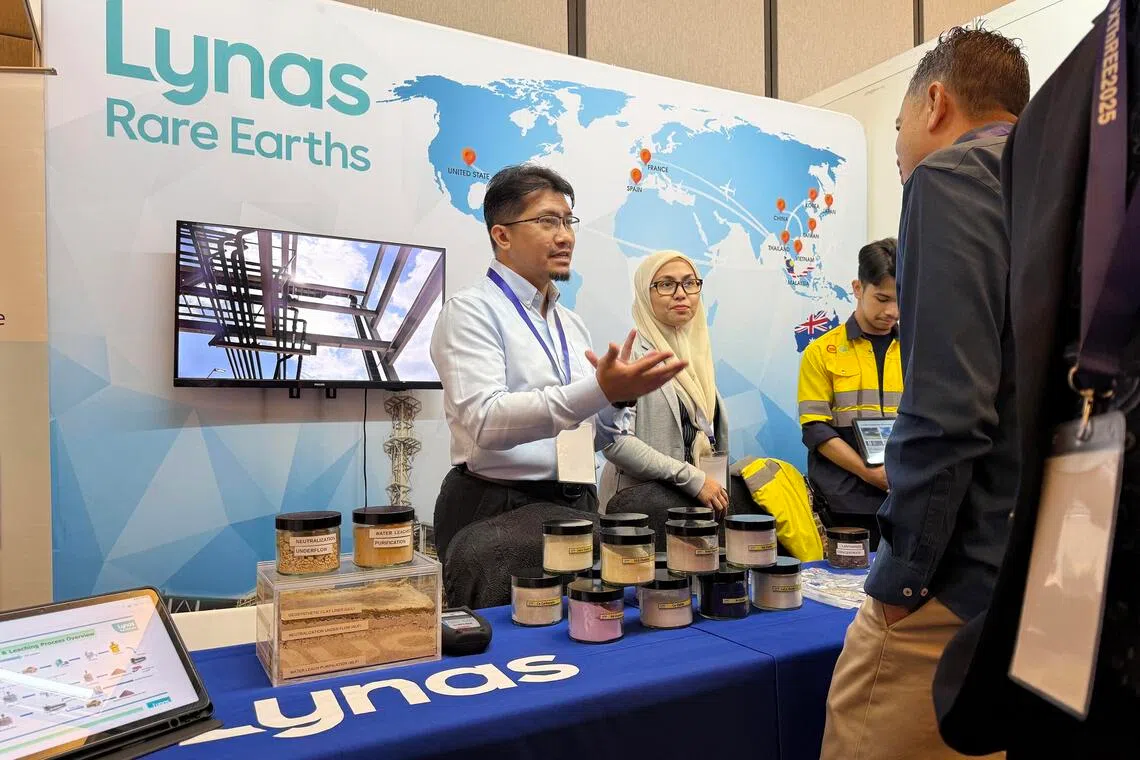Malaysia banks on Lynas’ expansion to become vital cog in rare earth supply chain
Sign up now: Get insights on the biggest stories in Malaysia

Lynas announced on Oct 29 that it will invest RM500 million (S$156 million) to expand its refinery in Gebeng, an industrial park near Kuantan.
ST PHOTO: SHANNON TEOH
Follow topic:
- Lynas expands its Malaysian operations with a RM500 million investment to increase rare earth production and partner with JS Link to make super magnets.
- Malaysia aims to become a key player in the global rare earth supply chain by 2030 and is banning raw material exports to develop midstream and downstream industries.
- Lynas's licence renewal is expected in 2026 while studies are ongoing to refine Malaysian ore, alongside concerns about pollution and radioactive waste management.
AI generated
PUTRAJAYA – Australian miner Lynas is expanding its Malaysian operations to not only produce more rare earths but also to make super magnets from the critical minerals crucial to high-tech applications in electronics and green energy.
These projects will make Malaysia a vital cog in the global supply chain of rare earths by 2030, according to government plans, by which time the rare earth industry could be worth up to US$28 billion (S$36.4 billion) globally.
Lynas announced on Oct 29 that it will invest RM500 million (S$156 million) to expand its refinery in Gebeng, an industrial park near Pahang’s capital Kuantan. It is also finalising a partnership with South Korean firm JS Link to make 3,000 tonnes of super magnets, a strong permanent magnet, at a neighbouring site.
The plans come amid a supply crunch of the critical minerals
Speaking on the sidelines of a rare earth trade event on Nov 3 in the Malaysian administrative capital of Putrajaya, Science, Technology and Innovation Minister Chang Lih Kang told The Straits Times that “God willing”, Lynas’ licence will be renewed in March 2026.
Mr Chang, who oversees the Atomic Energy Licensing Board (AELB), said the government is “happy with the progress” of the company’s research into extracting materials from its waste.
Lynas’ operations in Malaysia had sparked concerns about pollution, and the regulators had imposed additional conditions
In 2023, the government agreed that if Lynas can reduce the radiation level of its waste to below the threshold of AELB’s purview, it can continue to crack and leach in Malaysia the ore it imports from Australia.
The expansion of the Lynas refinery in Malaysia is expected to add 5,000 tonnes to its output per year, a 50 per cent increase over the 10,000 tonnes of rare earths it sold in its 2024 financial year.
Science, Technology and Innovation Ministry secretary-general Hasnol Zam Zam Ahmad said the rare earth sector contributes RM9.5 billion (S$2.97 billion) annually to the economy and is expected to create 24,800 jobs by 2030 under a moonshot REE (rare earth elements) programme that will include super magnets and electric motor production.
Prime Minister Anwar Ibrahim said after the Asia-Pacific Economic Cooperation economic leaders’ meeting in South Korea on Nov 1 that JS Link has already purchased the land
This follows a series of trade pacts inked by the US on rare earth supply with various nations in October, including Malaysia
Lynas’ Gebeng expansion is aimed at eventually processing Malaysian ore.
The refinery is currently only refining feedstock sourced from Lynas’ Mount Weld mine in Western Australia.
Lynas’ chief executive Amanda Lacaze told ST that the company has a memorandum of understanding with Kelantan to work towards processing the state’s rare earth deposits, and may be announcing an agreement with another state soon.
However, studies are needed to remove the normally occurring radioactive material in the ionic clay before it is taken to Lynas’ refinery. The ionic clay, in which Malaysia’s rare earth deposits are found, has a higher level of radiation than Lynas’ existing ore from Australia.
Another option to secure rare earth deposits is from tin tailings, said former AELB director-general Raja Abdul Aziz Raja Adnan at the rare earth event, referring to the residue from tin refining.
He was presenting as the head of research and development for the collaborative effort between Lynas and several local universities on extracting radioactive materials from the former’s waste product.
“Tin tailings have a huge amount of resources,” he said.
Said Ms Lacaze: “Whether ionic clay or tin tailings, Malaysian feedstock is crucial to developing the rare earth industry here.”
China currently dominates up to 90 per cent of global supply, according to some estimates, of the materials required to make cars, smartphones, wind turbines and even defence equipment.
At a summit in South Korea in October, US President Donald Trump and his Chinese counterpart Xi Jinping agreed on deals, including one that will see China ease exports controls on rare earths that had shuttered automobile production lines earlier in 2025.
But US Treasury Secretary Scott Bessent told the Financial Times in comments published on Nov 1 that by threatening to block exports of its rare earths, Beijing has prompted others to secure alternative supplies. He said China would not be able to keep using its critical minerals as a coercive tool
Datuk Raja Aziz, who has also served as special adviser to the International Atomic Energy Agency’s director-general, said “people ask why Trump came to Malaysia
Mr Chang told reporters on Nov 3: “We have already banned raw material export so we need to develop midstream and downstream. We cannot have one country (China) controlling all the resources. That will create vulnerabilities in the supply chain.”
So far, only a pilot mine in Perak had operated legally up to 2024 under a special exemption from the export ban. The raw ionic clay it sent for processing in China earned RM40 million in revenue for the state in 2023.
Trade data from Beijing shows that RM975 million worth of rare earths were shipped to China in 2023, making Malaysia the second-largest source of imported ore for the Asian giant, behind Myanmar.
But only 3,000 tonnes were exported legally
Sign up for our weekly
Asian Insider Malaysia Edition
newsletter to make sense of the big stories in Malaysia.


